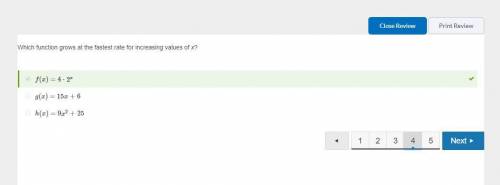Let f(x)=x2+3x−4 .
what is the average rate of change for the quadratic function from x=...

Mathematics, 29.09.2019 08:00 melissareid65
Let f(x)=x2+3x−4 .
what is the average rate of change for the quadratic function from x=−3 to x = 8?
let f(x)=−14(x+4)2−8 .
what is the average rate of change for the quadratic function from x=−2 to x = 2?
which function grows at the fastest rate for increasing values of x?
f(x)=4⋅2x
h(x)=9x2+25
g(x)=15x+6

Answers: 1


Another question on Mathematics

Mathematics, 21.06.2019 15:00
Use addition and subtraction to simplify the following polynomials. a. add polynomials: (3 – 4x + 8x^2) + (–6 + 2x – 5x^2) step 1: rewrite the polynomials without the parentheses. step 2: write the polynomial in descending order and use parentheses around like terms. step 3: add the like terms identified in step 2 to simplify the polynomial. b. subtract polynomials: (3x – 5 – 7x^2) – (–2 + 6x^2 – 5x) step 1: rewrite the polynomials without the parentheses. remember to multiply each term in the second parentheses by –1. show your work. step 2: write the polynomial in descending order and use parentheses around like terms. step 3: add the like terms identified in step 2 to simplify the polynomial.
Answers: 3

Mathematics, 21.06.2019 23:00
In january 2010, you began a one-year study of tuberculosis (tb) in a subsidized housing community in the lower east side of new york city. you enrolled 500 residents in your study and checked on their tb status on a monthly basis. at the start of your study on january 1st, you screened all 500 residents. upon screening, you found that 30 of the healthy residents had been vaccinated for tb and therefore were not at risk. another 20 residents already had existing cases of tb on january 1st. on february 1st, 5 residents developed tb. on april 1st, 10 more residents developed tb. on june 1st, 10 healthy residents moved away from new york city and were lost to follow-up. on july 1st, 10 of the residents who had existing tb on january 1st died from their disease. the study ended on december 31, 2010. assume that once a person gets tb, they have it for the duration of the study, and assume that all remaining residents stayed healthy and were not lost to follow-up. is the subsidized housing community in the lower east side of new york city a dynamic or fixed population? briefly explain the rationale for your answer. dynamic population it can changeable people can move out and move in into the population of a subsidized housing what was the prevalence of tb in the screened community on january 1st? prevalence = 30/500 0.06= 6% what was the prevalence of tb on june 30th? prevalence= 40/450=0.08= 8.88% what was the cumulative incidence of tb over the year? cumulative incidence = number of new cases/number in candidate population)over specified time period 10/450 = 2.2% suppose that you wanted to calculate the incidence rate of tb in the study population. calculate the amount of person-time that would go in the denominator of this incidence rate. be sure to show your work.
Answers: 2

Mathematics, 21.06.2019 23:00
The length of an intercepted arc of a central angle of a circle is 4 cm. if the radius of the circle is 5 cm what is the measurement of the central angle to the nearest whole degree
Answers: 2

Mathematics, 21.06.2019 23:30
What is the ratio for the surface areas of the cones shown below, given that they are similar and that the ratio of their radii and altitudes is 2: 1? submit
Answers: 1
You know the right answer?
Questions







Computers and Technology, 01.10.2019 16:20













English, 01.10.2019 16:20




